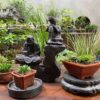The Difference Between Blue Willow China in England and the United States

Blue Willow China, one of the most recognizable patterns in the world of porcelain, has captured the hearts of collectors and homeowners alike for centuries. Originating in England in the late 18th century, the design quickly spread globally, reaching the United States by the early 19th century. Over time, the pattern’s popularity in both countries led to distinct variations in style, production methods, and cultural significance. This article will explore the differences between Blue Willow China in England and the United States, highlighting key factors such as design, manufacturing techniques, historical context, and the evolution of the pattern in both regions.
1. Historical Origins and Cultural Context
Blue Willow China was first introduced in England in the late 1700s, during the height of the Industrial Revolution. Its creation is credited to the English porcelain manufacturer, Thomas Minton, who designed the iconic blue-and-white pattern that has since become synonymous with classic porcelain. The design is said to have been inspired by Chinese porcelain, but it was distinctly adapted to suit Western tastes. This adaptation led to the creation of the Blue Willow pattern, which depicts a serene Chinese landscape featuring a pagoda, willow trees, birds, and a romanticized story of two lovers.
The story behind the Blue Willow pattern has varied versions, but most of them depict a tale of forbidden love between a Chinese princess and a humble commoner. In England, Blue Willow China became popular as a symbol of exoticism and a connection to the Orient, aligning with the Victorian era’s fascination with all things Eastern. The design was also a part of a larger trend in the West, where European ceramics manufacturers sought to emulate the beauty and mystique of Chinese porcelain.
In the United States, Blue Willow China was introduced in the 19th century, quickly gaining popularity during a time when the country was still growing and defining its identity. American manufacturers adopted the design, producing their own variations, and Blue Willow became a prominent feature in American homes, particularly among the growing middle class. The pattern’s affordability and elegance made it a staple of dinnerware and home décor, often displayed in the formal dining rooms of American households.
2. Design Differences Between English and American Blue Willow
While the core design of Blue Willow remains relatively consistent between England and the United States, there are notable differences in the interpretation and execution of the pattern in both regions. These differences primarily stem from cultural influences, manufacturing techniques, and market demands in each country.
English Blue Willow
In England, Blue Willow China was created with a high degree of artistic precision. The design typically adhered to a traditional, formal interpretation of the Chinese-inspired landscape, with intricate detailing in the birds, trees, and pagodas. The blue used in English Blue Willow China was typically a deep, rich cobalt blue, which became a signature of the design. The level of craftsmanship was high, especially in pieces produced by well-known manufacturers such as Minton, Spode, and Wedgwood.
English Blue Willow China often featured a more refined, elegant interpretation of the landscape. The patterns were meticulous, with the romantic story of the princess and her lover carefully rendered in scenes of beauty and grandeur. The production was often aimed at a more affluent audience, with elaborate pieces designed to be admired both for their artistic qualities and their functionality.
American Blue Willow
American versions of Blue Willow, while retaining the essential elements of the English design, often incorporated more practical and simplified elements. The American interpretation of Blue Willow was heavily influenced by the desire to make the pattern more affordable and accessible to a larger population. As a result, American manufacturers such as Homer Laughlin, McCoy, and Johnson Brothers produced versions of Blue Willow China that were less intricate and more mass-produced.
The blue color in American Blue Willow China was often a lighter, more vibrant shade compared to the darker, richer tones seen in the English versions. This was partly due to the differences in available glazes and firing techniques in the United States. American manufacturers often used more vibrant and bold blues to appeal to a broader market, giving American Blue Willow a slightly more casual and accessible feel.
In terms of design, American Blue Willow was often less detailed than its English counterparts. The scenes of the lovers, pagodas, and birds were more stylized and simplified, with less intricate detailing in the trees and landscapes. American Blue Willow China also became more standardized in terms of design, as manufacturers focused on mass production to meet the growing demand for affordable dinnerware.
3. Manufacturing Techniques and Material Differences
The manufacturing techniques and materials used to produce Blue Willow China differed between England and the United States, leading to some subtle yet important distinctions between the two.
English Blue Willow Production Techniques
English Blue Willow was produced using traditional methods of handcrafting and hand-painting, especially in the earlier years of production. Skilled artisans would hand-paint the intricate designs onto the porcelain, and each piece would be individually inspected for quality. This level of craftsmanship meant that English Blue Willow China was often more expensive, with each item considered a work of art.
The porcelain itself was of high quality, with many manufacturers, such as Wedgwood and Spode, using fine bone china or soft-paste porcelain. The use of bone china, which incorporated bone ash into the porcelain mix, was one of the distinguishing features of English pottery and contributed to the durability and delicacy of Blue Willow China. Bone china also allowed for fine details and a more translucent finish, making the blue-and-white design stand out in sharp relief.
American Blue Willow Production Techniques
In contrast, American manufacturers of Blue Willow China adopted more industrialized methods of production. The development of the American ceramics industry in the 19th and early 20th centuries was characterized by the use of mass-production techniques, including machine pressing and transfer printing, to create Blue Willow designs. These techniques allowed manufacturers to produce large quantities of dinnerware at a lower cost, making it accessible to a broader range of consumers.
The porcelain used in American Blue Willow was often less refined than the bone china used in England. While some high-end American manufacturers still produced fine porcelain, much of the Blue Willow China produced in the United States was made with earthenware or stoneware, which were more durable and cost-effective but lacked the delicacy of bone china. The transfer printing technique, in which the design was printed onto the surface of the china using engraved plates, also contributed to a less intricate, more uniform pattern.
4. The Popularity and Cultural Impact in Both Countries
Blue Willow China held different cultural meanings and roles in England and the United States, reflecting the social and historical contexts of each country.
Blue Willow in England
In England, Blue Willow China was often associated with the upper class and those with a taste for fine tableware. Its connection to the British aristocracy and the romanticized idea of the “Orient” made it a symbol of wealth and sophistication. The design’s intricacy and high craftsmanship also made it a favorite among collectors, who sought out rare and antique pieces.
The popularity of Blue Willow China in England coincided with the Victorian era’s fascination with exoticism and the allure of far-off lands. The romantic narrative embedded in the design, with its themes of love, longing, and loss, was in line with the Victorian taste for dramatic storytelling.
Blue Willow in the United States
In the United States, Blue Willow China became a symbol of middle-class aspiration. As industrialization and mass production grew, Blue Willow was no longer an exclusive item for the wealthy but became widely available to families across the nation. The pattern became a staple in American homes, especially during the late 19th and early 20th centuries. Its affordability and elegance made it an ideal choice for formal dining settings, where it was often used to serve guests and create an air of sophistication.
Blue Willow China also became associated with the idealized American dream, representing a connection to European traditions of elegance and high society while still being practical and affordable for everyday use. The widespread popularity of Blue Willow in the United States cemented its status as a beloved pattern, and it remains one of the most recognized designs in American ceramic history.
5. Conclusion: A Shared Legacy with Distinct Differences
In conclusion, while both England and the United States share a deep appreciation for Blue Willow China, the ways in which the design has been interpreted, produced, and valued in each country differ significantly. In England, Blue Willow was crafted as a fine art, with intricate designs and high-quality materials, often targeted at the elite class. In the United States, Blue Willow became a mass-market phenomenon, simplified in design and produced using industrial methods to meet the demands of a growing middle class.
Despite these differences, Blue Willow China remains an enduring symbol of both countries’ shared history of porcelain craftsmanship and cultural exchange. Whether displayed in a Victorian parlor or a modern American dining room, Blue Willow continues to be cherished for its beauty, storytelling, and timeless appeal.

